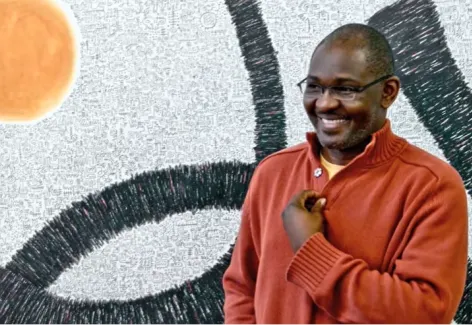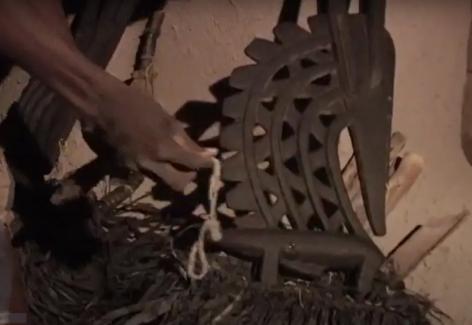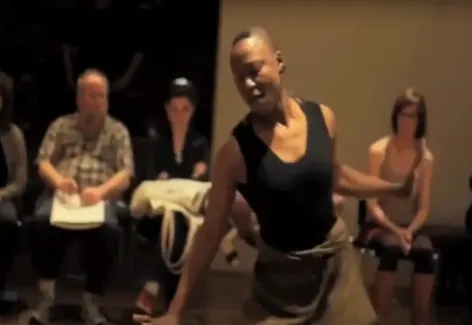KAM is excited to open its newly designed gallery devoted to the arts of Africa.
Sponsored in part by the Theresa and Harlan E. Moore Charitable Trust Fund, Krannert Art Museum; the Arnold O. Beckman Award, U of I Campus Research Board; and the Illinois Arts Council, a state agency
Visitors are welcomed by a completely renovated space with a new interpretive framework, casework, lighting, layout, and entranceways into the gallery. The thematically organized installation is inspired by the idea that objects can “tell” multiple stories, not only about themselves but also about the broader social contexts and often fraught global histories through which they have journeyed. Indeed, as a 21st century museum, KAM is committed to raising awareness about the “life histories” of African artworks, as well as the museum’s role in shaping our understanding of those histories.
The installation displays approximately 70 artworks from KAM’s African holdings, many of which had not been on view for decades. An 18th-century bronze hip mask from the Kingdom of Benin testified both to the mastery of the bronze casting workshops of the Oba’s court and to the illicit means by which many such objects were taken from the Oba’s palace during the British punitive expedition of 1897. Another collection highlight includes a grouping of small, intimate works by Chokwe, Kuba, Dogon, and Pende artists that were made to be held, carried, or serve otherworldly forces. These objects invite close examination and possess a grace that transcends their modest dimensions.
The installation is enhanced by loans from the Smithsonian Institute, the University of Iowa Museum of Art, the University of Wyoming Art Museum, and the University's Spurlock Museum, all of which were selected to create meaningful connections with KAM's collection. For instance, paired with one of KAM's chi wara masks - a composite animal sculpture based on a mythical creature that taught the Bamana people to farm - is a chi wara-inspired sculpture constructed entirely from used bicycle parts by African American artist Willie Cole, on loan from the University of Wyoming Art Museum. Though whimsical in appearance, Cole's hybrid chi wara sculpture speaks to the artist's deeper interest in the transformative powers and resonant histories of African forms.
Also new to the gallery is the addition of several visitor-activated iPads to complement conventional, text-based labels and to encourage more varied encounters with the artworks. Each iPad will display a menu of videos relating to select objects on view and will include interviews with artists, narrative vignettes, and masquerade clips that allow visitors to see masks as they were intended by their makers - in motion and in spirited engagement with a crowd of spectators. Because KAM sees this installation as flexible and open to change, the iPad technology will allow the museum to continue experimenting with new ways of using media in the galleries - an effort which has been supported by fruitful collaborations with colleagues at CITES - Campus Information Technology and Educational Services.
Until recently, KAM's African collection was comprised solely of the tradition-based arts of West and Central Africa, the vast majority of which were generously donated to the museum by two very passionate collectors of African art, Richard J. Faletti and Irwin Smiley. In the spirit of introducing visitors to African contemporary studio-based practices and to the long participation of African artists in the global arts scene, KAM recently acquired five contemporary artworks by internationally acclaimed artists, four of which will be displaed in the new gallery in meaningful conjunction with the tradition-based works. These include a painting by Ethiopian artist Wosene Worke Kosrof (Migrations II, 2006); a suite of paintings by Senegalese art activist Yelimane Fall (Seven Lines from Djawartu, 2003-04); a ceramic vessel by Kenyan born artist Magdalene Odundo (Untitled, 2009); and a photograph by the late Nigerian-British artist, Rotimi Fani-Kayode (Dan Mask, 1989).
As a university museum, KAM has benefited from collaborations with graduate and undergraduate students and faculty across a range of disciplines. Their creative energies have contributed in numerous ways to the reinstallation, as research assistants, translators, or facilitators of community outreach.
Above all, KAM's African gallery will celebrate the cultural richness, global reach, and contemporary relevance of the visual arts of Africa. We hope it will inspire new ways of seeing these arts, and encourage us to reflect on our own diverse histories and connections to the arts of Africa and its diasporas.
The renovated exhibition space and installation design for the African Gallery was conceived and detailed by Rice+Lipka Architects, New York, New York. An accompanying brochure for the reinstallation was designed by Studio Blue, Chicago.
Select Programming
October 25, 2012
Gallery Conversation “Creating Community Through African Art” with Anne Lutomia, doctoral student in Education Policy, Organization and Leadership; Sam Smith, engagement director of Krannert Center for the Performing Arts; and Mabinty Tarawallie, master’s student in Social Work. Moderated by Allyson Purpura, curator
December 7, 2012
The African Francophone Choir with Yamfu Nlandu, choir director, accompanied by live band
Curator: Allyson Purpura, curator of Global African Art







